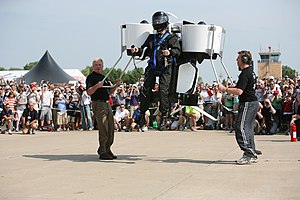Martin Jetpack

| The Martin Jetpack flying at AirVenture 2008. | |
| Role | Ultralight aircraft |
| National origin | New Zealand |
| Manufacturer | Martin Aircraft Co. |
| Designer | Glenn Martin |
| Introduction | 2008 |
| Status | For sale now |
| Unit cost | |
History
The Martin Jetpack has been under development for over 30 years. Glenn Neal Martin[3] (not Glenn L. Martin, of US Martin Aircraft) started work on it in his Christchurch garage in the 1980s.[4]New Zealand aviation regulatory authorities approved the Martin Jetpack for a limited set of manned flight tests in 2013.[4] As of 2016 the price of the commercial production units is expected to be US$250,000[1] and sell in the US for US$250,000-350,000 subject to local tax and customization requirements.[4]
Glenn Martin suddenly resigned on 4 June 2015 after investing 30 years in the product. He says now he can spend more time with his family and has other business projects. His concluding statement was, "I only have two pieces of advice. Deliver the dream that people want, not the product that is easiest to build. Now don't f... it up!" [5]
Description
The Martin Jetpack is a small VTOL device with two ducted fans that provide lift and a 2.0-litre V4 piston 200-horsepower gasoline engine.[6] Although its pilot straps onto it and does not sit, the device cannot be classed as a backpack device because it is too large to be worn while walking. Although the Martin Jetpack does not meet the Federal Aviation Administration's classification of an ultralight aircraft: it meets weight and fuel restrictions, but it cannot meet the power-off stall speed requirement. The intention is to create a specific classification for the jetpack - it uses the same petrol used in cars, is relatively easy to fly, and is cheaper to maintain and operate than other ultralight aircraft. Most helicopters require a tail rotor to counteract the rotor torque, which, along with the articulated head complicate flying, construction, and maintenance enormously. The Martin Jetpack is designed to be torque neutral – it has no tail rotor, no collective, no articulating or foot pedals – and this design simplifies flying dramatically. Pitch, roll and yaw are controlled by one hand, height by the other.[7]Version P12
A further version of the Martin Jetpack has been built to prepare for manned flight testing. The new prototype, with the descriptor P12, has several design improvements over earlier versions, including lowering the position of the Martin Jetpack's ducts, which has reportedly resulted in much better maneuverability.[4] It also has a fully integrated fly by wire system. P12 will be developed into a First Responder production model. A lighter personal jetpack should be available in 2016.[8]Safety features
In order to enhance safety, the finished product will feature a low opening ballistic parachute along with carbon fibre landing gear and pilot module.[8]Flight testing
On 29 May 2011, the Martin Jetpack successfully completed a remotely controlled unmanned test flight to 1,500 m (5,000 ft) above sea level, and carried out a successful test of its ballistic parachute.[9][10]A second version, designated prototype P12, of the Martin Jetpack received approval from the New Zealand Civil Aviation Authority (CAA) to begin manned flight testing in August 2013.[4]
Potential Markets
In 2015 the company as part of its listing on the Australian Securities Exchange (ASX:MJP) stated that the jetpack could be available on the market as in late 2016; it was expected to sell for approximately US$250,000,[1][11] however in December 2015 the price per unit was announced to be about $200,000.[12]Governments are expected to be a large share of initial consumers. The first production model aimed at military and first responder emergency crews, such as police, firefighters, and medical personnel, enabling them to have faster response times, to reach areas inaccessible by road, and to get to the top of tall buildings quickly.[11] Interested buyers include the government of the United Arab Emirates;[12] it was reported in November 2015 that Dubai (part of the UAE) had placed an initial order for twenty units, simulators, and training, for delivery in 2016.[8][11]
A more basic model for the general public may be available by 2016.[4]
Specifications
Type of aircraft: Class one microlight
Data from Company Web site[2]
General characteristics- Crew: 1 pilot
- Payload: 120 kg ()
- Length: 5 ft 7 in (1.75 m)
- Rotor diameter: ()
- Height: 7 ft (2.2 m)
- Max. takeoff weight: 320 kg (320kg)
- Powerplant: 1 × Martin Aircraft Company 2-litre (120 cu in) two-stroke V-4 engine, 200 hp (150 kw)
- Propellers: Carbon / Kevlar composite - ducted fans in each engine propeller
- Fuel capacity: 45 Litres
- Maximum speed: 74 km/h
- Cruise speed: 56 km/h
- Stall speed: 0 km/h (0 km/h)
- Range: 30–40 km ()
- Combat radius: @74 km/h + 5 min rev = 56 km ()
- Endurance: 30 min to 50 min
- Service ceiling: 3,000 ft amsl ()
- Rate of climb: 400 fpm ()
- sink rate: 400 fpm ()

No comments:
Post a Comment